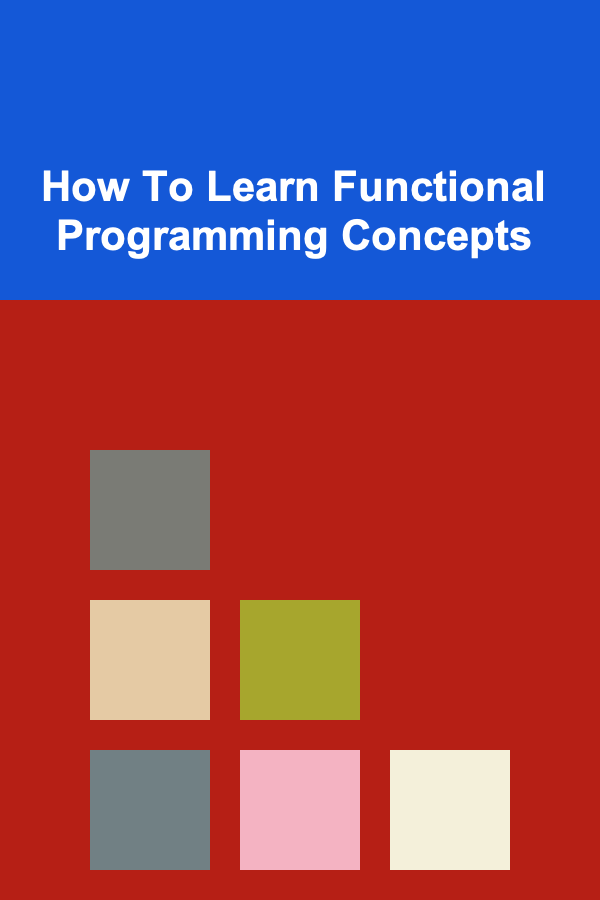
How To Learn Functional Programming Concepts
ebook include PDF & Audio bundle (Micro Guide)
$12.99$6.99
Limited Time Offer! Order within the next:

Functional programming (FP) is a paradigm that emphasizes the use of functions to transform data, rather than relying on state-changing operations. It is one of the primary paradigms in computer science, alongside imperative and object-oriented programming. Learning functional programming can be both rewarding and challenging. It opens up a new way of thinking about software design and can improve the scalability, readability, and maintainability of your code.
In this article, we will dive deep into the fundamental concepts of functional programming, how to learn them effectively, and how to integrate them into your coding practices. Whether you are a beginner or have experience with other programming paradigms, this guide will help you understand and implement functional programming principles.
What is Functional Programming?
Functional programming is a style of programming that treats computation as the evaluation of mathematical functions and avoids changing state and mutable data. In functional programming, functions are first-class citizens, which means that they can be assigned to variables, passed as arguments to other functions, and returned from other functions.
Key concepts in functional programming include:
- Pure Functions
- Immutability
- Higher-order Functions
- First-class Functions
- Lazy Evaluation
- Recursion
- Function Composition
- Monads
These concepts together form the backbone of functional programming, allowing developers to write clean, modular, and declarative code.
Step 1: Start with the Basics of Functional Programming
Before diving into advanced functional programming techniques, it is essential to build a strong foundation. Here are the most important basic concepts you need to understand to get started with functional programming:
1.1 Pure Functions
A pure function is a function that always produces the same output for the same input and has no side effects. Side effects include modifying external variables, performing I/O operations, or changing the state of the system. The hallmark of pure functions is predictability.
For example, consider the following JavaScript function:
This function is pure because it always returns the same result when given the same inputs (i.e., add(2, 3) will always return 5), and it has no side effects.
1.2 Immutability
Immutability refers to the idea that once a value is assigned, it cannot be changed. Instead of modifying existing data, new data structures are created with the updated values. This leads to fewer bugs and easier reasoning about the state of the system.
In functional programming, you generally avoid changing the value of variables after they are created. Instead, you create new copies with modified data when necessary.
For example, if you're working with a list of numbers, instead of modifying the list directly, you might create a new list with the modified values:
const newNumbers = numbers.map(x => x * 2); // [2, 4, 6]
In this case, the original numbers array remains unchanged, and newNumbers contains the transformed data.
1.3 First-Class Functions
In functional programming, functions are first-class citizens, meaning they can be treated just like any other variable. You can assign functions to variables, pass them as arguments, and return them from other functions.
For example:
```const greet = (name) => Hello, ${name}!; const sayHello = greet; // Function is assigned to another variable console.log(sayHello('Alice')); // Output: "Hello, Alice!"
This ability to treat functions as values is one of the defining features of functional programming.
### 1.4 Higher-Order Functions
A higher-order function is a function that either takes one or more functions as arguments, returns a function as a result, or both. Higher-order functions enable the creation of more abstract, reusable, and composable code.
For example, the `map` function in JavaScript is a higher-order function because it takes a function as an argument and applies it to each element in an array:
```const numbers = [1, 2, 3];
const doubled = numbers.map(x => x * 2); // [2, 4, 6]
Here, map takes a function (x => x * 2) as an argument and returns a new array.
Step 2: Learn More Advanced Concepts
Once you're comfortable with the basic principles of functional programming, you can start exploring more advanced topics. These concepts will deepen your understanding of functional programming and provide powerful tools for solving complex problems.
2.1 Recursion
Recursion is a technique where a function calls itself to solve smaller instances of a problem. Functional programming encourages the use of recursion instead of traditional looping constructs like for and while. Recursion is a natural fit for problems that can be broken down into smaller, similar subproblems, such as traversing data structures like trees and lists.
For example, here's a simple recursive function to calculate the factorial of a number:
This function calls itself with a smaller value of n until it reaches the base case (n === 0), at which point it stops and returns the result.
2.2 Function Composition
Function composition refers to combining multiple functions to create a new function. This is a common pattern in functional programming, where smaller, simpler functions are combined to create more complex behavior. In function composition, the output of one function becomes the input of another.
In JavaScript, you can create a function composition utility as follows:
const add2 = (x) => x + 2;
const multiplyBy3 = (x) => x * 3;
const add2ThenMultiplyBy3 = compose(multiplyBy3, add2);
console.log(add2ThenMultiplyBy3(4)); // Output: 18
Here, add2ThenMultiplyBy3 first adds 2 to x and then multiplies the result by 3. Function composition enables you to build complex functions from simple, reusable components.
2.3 Lazy Evaluation
Lazy evaluation is a technique where expressions are not evaluated until their values are needed. This can improve performance by avoiding unnecessary calculations. In functional programming, lazy evaluation is often used in conjunction with infinite data structures or when working with large datasets.
For example, in JavaScript, you can create an iterator that generates values lazily:
let num = 1;
while (true) {
yield num++;
}
}
const numbers = generateNumbers();
console.log(numbers.next().value); // Output: 1
console.log(numbers.next().value); // Output: 2
In this example, generateNumbers produces values lazily, and the next number is generated only when it is requested.
2.4 Monads
Monads are a more advanced concept in functional programming, often associated with handling side effects, chaining computations, and managing state. They provide a way to structure computations in a consistent manner.
While the concept of monads can be difficult to grasp at first, understanding their role in functional programming can provide powerful tools for managing side effects and complex computations.
In JavaScript, promises are a simple form of monads used for asynchronous programming:
fetchData()
.then((data) => console.log(data)) // Output: "data"
.catch((error) => console.error(error));
Monads allow you to work with computations in a controlled, predictable manner.
Step 3: Practice Functional Programming with a Language of Your Choice
The best way to learn functional programming is by applying the concepts in real code. Many modern programming languages support functional programming, and some are designed specifically for it.
3.1 Choose a Functional Programming Language
Several programming languages are designed to support functional programming, and some offer robust features for it. Popular functional programming languages include:
- Haskell: A purely functional language with a strong emphasis on immutability and recursion.
- Scala: A hybrid language that supports both object-oriented and functional programming.
- F#: A functional-first language that runs on the .NET platform.
- Elixir: A functional language built for concurrent, distributed systems.
If you're new to functional programming, it may be easier to start with a multi-paradigm language like JavaScript , Python , or Ruby, as they support functional programming concepts while allowing you to mix in other styles.
3.2 Solve Real-World Problems
The key to mastering functional programming is practice. Start by solving real-world problems using functional programming techniques. Try implementing algorithms, working with data structures, and building applications using only functional programming principles. This will help you solidify your understanding and gain practical experience.
3.3 Learn from the Community
Functional programming has a passionate community of developers who share their knowledge and experience. Participate in online forums, attend meetups or conferences, and contribute to open-source projects that use functional programming. This will help you stay up to date with the latest trends and improve your skills through collaboration.
Conclusion
Learning functional programming can be a transformative experience for any developer. It shifts the way you approach problems and encourages a more declarative, modular, and predictable style of programming. By understanding the core concepts of pure functions, immutability, higher-order functions, and recursion, you can begin to think like a functional programmer.
To master functional programming, practice is key. Work through challenges, apply functional techniques in your daily work, and continue to deepen your understanding of advanced concepts like lazy evaluation and monads. With time and dedication, you'll be able to unlock the full potential of functional programming and become a more effective, efficient, and thoughtful developer.

How to Create a Checklist for Workplace Emergency Kits
Read More
How to Store Seasonal Linens and Bedding in the Laundry Room
Read More
How to Use Socially Responsible Investing (SRI) for Ethical Returns
Read More
The Electrical Engineer's Guide: Mastering Circuit Design and Power Systems
Read More
Understanding Bird Molting Seasons: A Comprehensive Guide
Read More
10 Tips for Reducing Food Waste with Smart Grocery Lists
Read MoreOther Products

How to Create a Checklist for Workplace Emergency Kits
Read More
How to Store Seasonal Linens and Bedding in the Laundry Room
Read More
How to Use Socially Responsible Investing (SRI) for Ethical Returns
Read More
The Electrical Engineer's Guide: Mastering Circuit Design and Power Systems
Read More
Understanding Bird Molting Seasons: A Comprehensive Guide
Read More